As Jaipur grapples with creating safe, vibrant public spaces for its youth, looking outward at global and national examples can spark fresh ideas. In exploring inclusive public space design, I studied standout case studies – from Medellín’s “library parks” to UN-Habitat’s youth-led digital placemaking – to understand how other cities have tackled issues similar to ours. Below are three initiatives that illustrate participatory design, gender-sensitive planning, and policy frameworks that prioritise inclusivity.
Case Studies from Other Cities
Medellín’s Library Parks (Parques Biblioteca)
To bridge deep divides in access and safety, Medellín placed modern libraries in underserved neighborhoods, surrounded by green, welcoming public spaces. These “library parks” became cultural and learning hubs, offering internet, after-school programs, and safe zones for community gathering.
What stood out was the way public infrastructure was layered with community programming and long-term stewardship. Jaipur could learn from this by rethinking public amenities not as isolated plots, but as integrated social anchors. In adolescent-dense areas like Bhatta Basti or Hasanpura, combining parks with libraries, sports, and learning spaces could serve multiple needs – education, recreation, and visibility – within a single, inclusive zone.
Just as Medellín institutionalized public space as part of its urban recovery, Jaipur could benefit from embedding multi-functional public hubs into city planning, with adequate funding and maintenance built in from the start.
Block by Block: Youth-Led Digital Placemaking
This UN-Habitat initiative uses Minecraft to let adolescents redesign their neighborhoods, turning a digital game into a tool for participatory urban planning.
It’s not the software that inspired me – it’s the principle. This project demonstrates that when young people are given agency and the right tools, they shift from passive users to active co-creators of public space. Jaipur’s public space processes could evolve by inviting adolescents into the early stages of design, especially those from underserved and often unheard communities. While Minecraft may not be the tool here, low-tech methods – like scaled maps, drawings, and storytelling – can serve the same purpose.
This approach could help adolescents move from users to co-creators of space, building local ownership and ensuring that interventions actually reflect their lived realities and aspirations.
UN-Habitat’s Global Public Space Toolkit
UN-Habitat’s Global Public Space Toolkit outlines policy actions and design principles – from securing land for public use in advance, to embedding gender audits in street design – that cities can adapt. It serves as a practical guide for making public spaces more inclusive, safe, and equitably governed.
The emphasis on process, not just product, feels especially urgent for Jaipur. Instead of viewing public space safety as a checklist item, Jaipur could adopt gender audits as a foundational step – examining lighting, visibility, access routes, and time-based usage patterns with direct input from women and girls.
Moreover, the recommendation to form multi-stakeholder public space committees- with youth, women’s groups, NGOs, and municipal representatives- could be a vital next step. Such a structure would allow for sustained feedback, shared responsibility, and better maintenance of redesigned spaces over time.
How These Lessons Inform My Approach
Through the Safe, Vibrant, and Healthy Public Spaces (SVHPS) project in Jaipur, led by WRI India, I’ve had the opportunity to engage closely with adolescents in co-creating public spaces. While the project has its own distinct goals and methodology, I find strong resonance between its on-ground activities and the strategies seen in global best practices.
Participatory Design with Adolescents
Drawing a parallel with initiatives like Block by Block, SVHPS has facilitated youth-led engagement through design thinking workshops, mapping sessions, and site zoning exercises. These low-tech, collaborative formats are helping adolescents, especially from underserved communities, articulate how they use, perceive, and imagine public space.
Gender-Sensitive Site Audits
Drawing a parallel with tools like UN‑Habitat’s global guide, SVHPS in Jaipur is piloting assessments using the Public Spaces Assessment Framework (PSAF), developed with over 800 adolescents, to evaluate factors like lighting, visibility, amenities, and comfort in public spaces. These assessments generate experiential insights that can inform design interventions in future phases.
Toward Collaborative Public Space Governance
While Jaipur does not currently have a formal public space committee, SVHPS has enabled multi-stakeholder discussions involving youth, NGOs, urban designers, and municipal actors. I see this as a foundational step toward more participatory and accountable governance models – similar in spirit to the structures recommended by global toolkits.
By drawing these parallels, I find that even within a local pilot, global principles of participation, gender inclusion, and sustained engagement are taking root. The challenge now is to scale these ideas systemically, so Jaipur’s public spaces not only serve adolescents, but are shaped by them.


